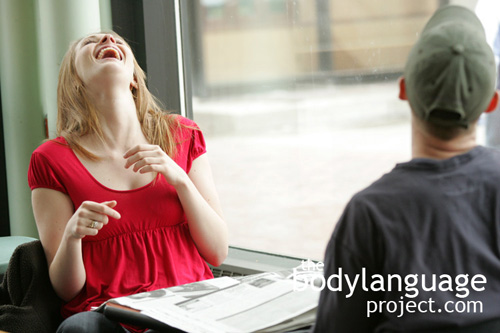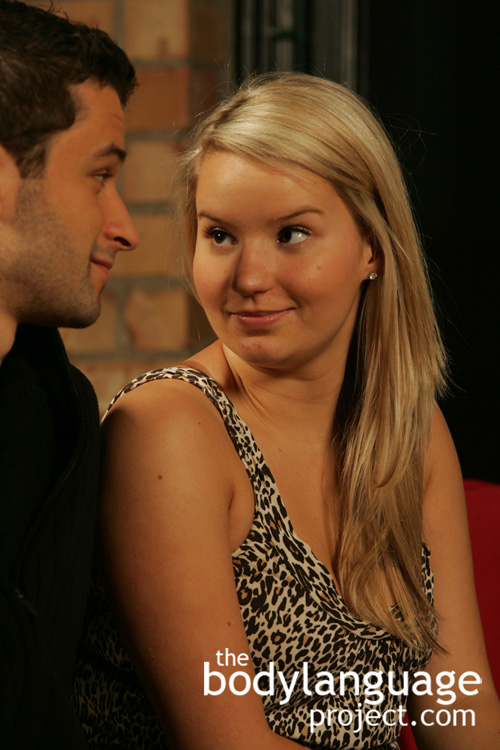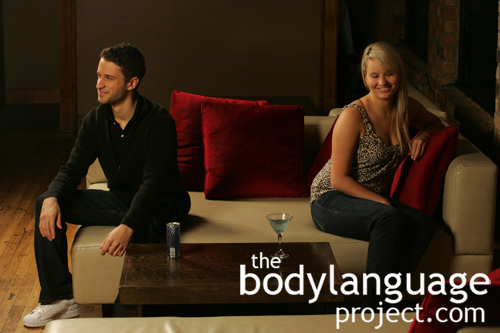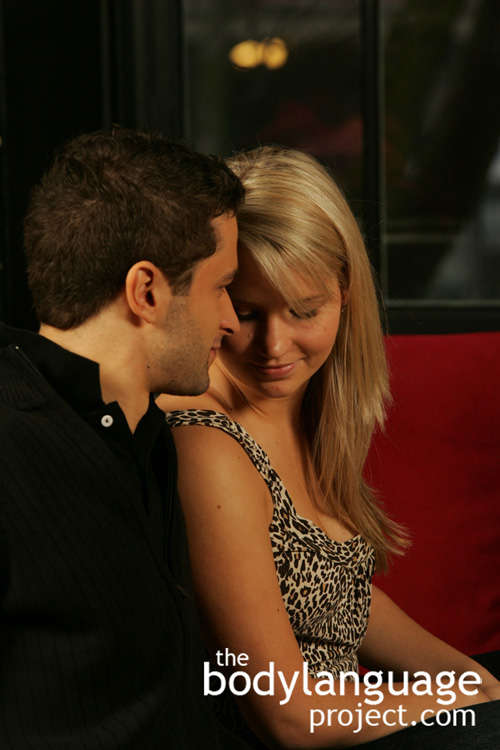Body Language of Grin, Smirk or Closed-Lip Grin
 Cue: Grin, Smirk or Closed-Lip Grin
Cue: Grin, Smirk or Closed-Lip Grin
Synonym(s): Smirk, Closed-Lip Grin
Description: This is a smile done by keeping the mouth closed, teeth hidden, and curling up the corners of your lips.
In One Sentence: The grin is a type of smile that is mischievous.
How To Use it: Use the grin to signal that you are “up to no good.” This can work well in intimate relationships as a way to tease. Men can use this to good effect to create a ‘bad-boy’ type impression which can leave women guessing. This can help spark sexual interest.
Children can also use the grin to good effect against parents as it is often seen as playful and cheeky and not particularly troublesome.
One should avoid the grin when dealing with authoritative figures as these people, especially when under stress, may not take well to humour.
Context: General.
Verbal Translation: “I’m holding back information and not being totally open and honest which is why I’m not doing a full smile and exposing all my teeth.”
Variant: See Smiling, Fear Smile, Friendly Smile, Frown (the) or Downturned Smile, Honest Smile or Duchenne Smile, Jaw Drop Smile, Nervous Smile, Polite Smile (the), Uneven Smile Or Lopsided Smile, Upper Lip Smile, Artificial Smile or Fake Smile, Nervous Smile, Honest Smile or Duchenne Smile, Contempt Facial Expression.
Cue In Action: Dave set up a prank on his good buddy when he was away picking up lunch. When his buddy realized that his cubicle had been “redecorated,” Dave cracked his lips in a grin.
Meaning and/or Motivation: This smile indicates smugness, arrogance, or hiding of information or feelings.
It is a tight lipped smile with the addition of a degree self satisfaction for good measure.
The close lipped smile is a restraint and concealment smile commonly associated with politicians and those who are up to no good. Children are sometimes seen sporting this smile, as are people who are teasing or being playful. If someone is speaking, but holding a tight grin, you can be assured that they aren’t telling you everything.
Sometimes the smile is done to hide bad or yellow teeth. An honest smile bares the teeth.
Cue Cluster: The smirk has accompanying dominant body language such as head back, shoulders back, open postures along with dialogue riddle with exuberant pride.
Body Language Category: Appease, Clenching and gripping, Closed facial gestures, Defensive, Dislike (nonverbal), Lying or deceptive body language, Masked emotions, Negative body language.
Resources:
Abel, Ernest L. and Michael L. Kruger. Smile Intensity in Photographs Predicts Longevity. Psychological Science. 2010. 21(4): 542-544.
Seder, J. Patrick and Shigehiro Oishi. Intensity of Smiling in Facebook Photos Predicts Future Life Satisfaction. Social Psychological and Personality Science. 2012. 3(4): 407-413.
http://bodylanguageproject.com/articles/facebook-smile-predicts-life-satisfaction/
Colonnesi, Cristina; Susan M. Bogels; Wieke de Vente and Mirjana Majdandzic. What Coy Smiles Say About Positive Shyness in Early Infancy. Infancy. 2013. 18(2): 202–220. ISSN: 1525-0008 print / 1532-7078 online
DOI: 10.1111/j.1532-7078.2012.00117.x
http://bodylanguageproject.com/articles/nonverbal-meaning-coy-smiles-infants/
Fairbairn, Catharine E.; Michael A. Sayette; Odd O. Aalen and Arnoldo Frigessi. Alcohol and Emotional Contagion: An Examination of the Spreading of Smiles in Male and Female Drinking Groups. Clinical Psychological Science. 2014. DOI: 2167702614548892
http://bodylanguageproject.com/articles/alcohol-social-lubricant-male-smiles/
Gosselin, Pierre; Reem Maassarani; Alastair Younger and Mélanie Perron. Children’s Deliberate Control of Facial Action Units Involved in Sad and Happy Expressions. Journal of Nonverbal Behaviour. 2011. 35:225–242. DOI 10.1007/s10919-011-0110-9.
http://bodylanguageproject.com/articles/childrens-control-facial-actions-improve-age-create-accurate-emotional-expressions/
Gunnery, Sarah D.; Judith A. Hall and Mollie A. Ruben. The Deliberate Duchenne Smile: Individual Differences in Expressive Control. Journal of Nonverbal Behavior. 2013. 37:29–41. DOI 10.1007/s10919-012-0139-4
http://bodylanguageproject.com/articles/can-probably-fake-honest-smile-deliberate-duchenne-smile/
Golle, Jessika; Fred W.; Mast and Janek S. Lobmaier. Something to Smile About: The Interrelationship Between Attractiveness and Emotional Expression. Cognition and Emotion, 2014. 28:2: 298-310. DOI: 10.1080/02699931.2013.817383.
http://bodylanguageproject.com/articles/smiles-arent-just-cameras/
Guéguen, N. The Effect Of A Woman’s Smile On Men’s Courtship Behavior. Social Behavior and Personality. 2008. 36(9): 1233-1236.
http://bodylanguageproject.com/articles/how-women-can-use-a-simple-smile-to-attract-men/
Guéguen, N., & Fischer-Lokou, J. (2004). Hitchhiker’s Smiles And Receipt Of Help. Psychological Reports. 94: 756-760.
Gueguen, Nicolas. Weather and Smiling Contagion: A Quasi Experiment With the Smiling Sunshine. Journal of Nonverbal Behavior. 2013. 37:51–55. DOI 10.1007/s10919-012-0140-y
http://bodylanguageproject.com/articles/weather-smile-not-contagion-smile-linked-weather-conditions/
Hertenstein, Matthew J.; Carrie A. Hansel; Alissa M. Butts and Sarah N. Hile. Smile Intensity In Photographs Predicts Divorce Later In Life. Motiv Emot. 2009; 33:99-105
DOI 10.1007/s11031-009-9124-6
http://bodylanguageproject.com/articles/small-smiles-predicts-divorce/
Harker, L., & Keltner, D. (2001). Expressions Of Positive Emotion In Women’s College Yearbook Pictures And Their Relationship To Personality And Life Outcomes Across Adulthood. Journal of Personality and Social Psychology, 80(1), 112–124. doi: 10.1037/0022-3514.80.1.112.
Kraft, Tara L ; Pressman, Sarah D. Grin and Bear It. Psychological Science. 2012. 23(11): 1372-1378.
Kalokerinos, Elise K. ; Greenaway, Katharine H. ; Pedder, David J. ; Margetts, Elise A. Desteno, David (editor). Don’t Grin When You Win: The Social Costs of Positive Emotion Expression in Performance Situations. Emotion. 2014. 14(1): 180-186.
Krumhuber, E., Manstead, A., & Kappas, A. Temporal Aspects of Facial Displays in Person and Expression Perception: The Effects of Smile Dynamics, Head-tilt, and Gender. Journal of Nonverbal Behavior. 2007. 31(1), 39-56.
http://bodylanguageproject.com/articles/slow-onset-smile-best/
Krause, Michael W. and Teh-Way David Chen. A Winning Smile? Smile Intensity, Physical Dominance, and Fighter Performance. Emotion. 2013. 13 (2): 270–279. DOI: 10.1037/a0030745
http://bodylanguageproject.com/articles/smile-lose-smile-intensity-predicts-fighting-ability
Krumhuber, Eva G.; Manstead and Antony S. R. Can Duchenne smiles be feigned? New evidence on felt and false smiles. Emotion. 2009. 9 (6): 807-820.
http://bodylanguageproject.com/articles/can-fake-real-smile-practice/
Krumhuber, Eva; Antony S. R.; Manstead; and Arvid Kappas. Temporal Aspects of Facial Displays in Person and Expression Perception: The Effects of Smile Dynamics, Head-tilt, and Gender. Journal Nonverbal Behavior. 2007; 31: 39-56. DOI 10.1007/s10919-006-0019-x
http://bodylanguageproject.com/articles/head-tilt-and-slow-onset-smile-nonverbals-trust-attraction-dominance-and-flirting-a-brief-report/
Labroo, Aparna A.; Anirban Mukhopadhyay; Ping Dong. Not Always the Best Medicine: Why Frequent Smiling Can Reduce Wellbeing. Journal of Experimental Social Psychology. 2014. 53:156-162.
http://bodylanguageproject.com/articles/why-too-much-smiling-can-be-bad-for-you/
Lockard, J. S., McVittie, R. I., & Isaac, L. M. (1977). Functional Significance Of The Affiliative Smile. Bulletin of the Psychonomic Society, 9, 367-370.
Okubo, Matia; Akihiro, Kobayashi and Kenta Ishikawa. A Fake Smile Thwarts Cheater Detection. Journal of Nonverbal Behaviour. 2012. 36:217–225. DOI 10.1007/s10919-012-0134-9
http://bodylanguageproject.com/articles/fake-till-make-cheaters-fake-smile-make-lies-difficult-detect/
Reissland, Nadja; Brian Francis, James Mason, Karen Lincoln. Do Facial Expressions Develop before Birth? August 2011. 6(8): e24081. doi:10.1371/journal.pone.0024081.g001
http://bodylanguageproject.com/articles/the-cry-and-laugh-face-in-the-human-fetus/
Reed, Lawrence Ian; Katharine N. Zeglen and Karen L. Schmidt. Facial Expressions as Honest Signals of Cooperative Intent in a One-Shot Anonymous Prisoner’s Dilemma Game. Evolution and Human Behavior. 2012. 33: 200-209.
http://bodylanguageproject.com/articles/facial-expressions-honest-signals-smiling-contempt-predict-cooperation-defection/
Samuele Centorrino, Elodie Djemai, Astrid Hopfensitz, Manfred Milinski, Paul Seabright. Honest Signaling in Trust Interactions: Smiles Rated as Genuine Induce Trust and Signal Higher Earning Opportunities. Evolution and Human Behavior DOI: dx.doi.org/10.1016/j.evolhumbehav.2014.08.001.
http://bodylanguageproject.com/articles/smile-great-gain-smiling-key-negotiation/
Tidd, K., & Lockard, J. (1978). Monetary Significance Of The Affiliative Smile: A Case For Reciprocal Altruism. Bulletin of the Psychonomic Society, 11, 344-346.
Vazire, S., Naumann, L.P., Rentfrow, P. J., and Gosling, S. D. (2009). Smiling reflects different emotions in men and women. Behavioral and Brain Sciences, 32:5, 403–405.
http://bodylanguageproject.com/articles/smiling-reflects-different-emotions-men-women/
Vigil, J. M. (2009). A socio-relational framework of sex differences in the expression of emotion. Behavioral and Brain Sciences, 32, 375–428.
Walsh, D. G., & Hewitt, J. (1985). Giving Men The Come-On: Effect Of Eye Contact And Smiling In A Bar Environment. Perceptual and Motor Skills, 61, 873-874.









